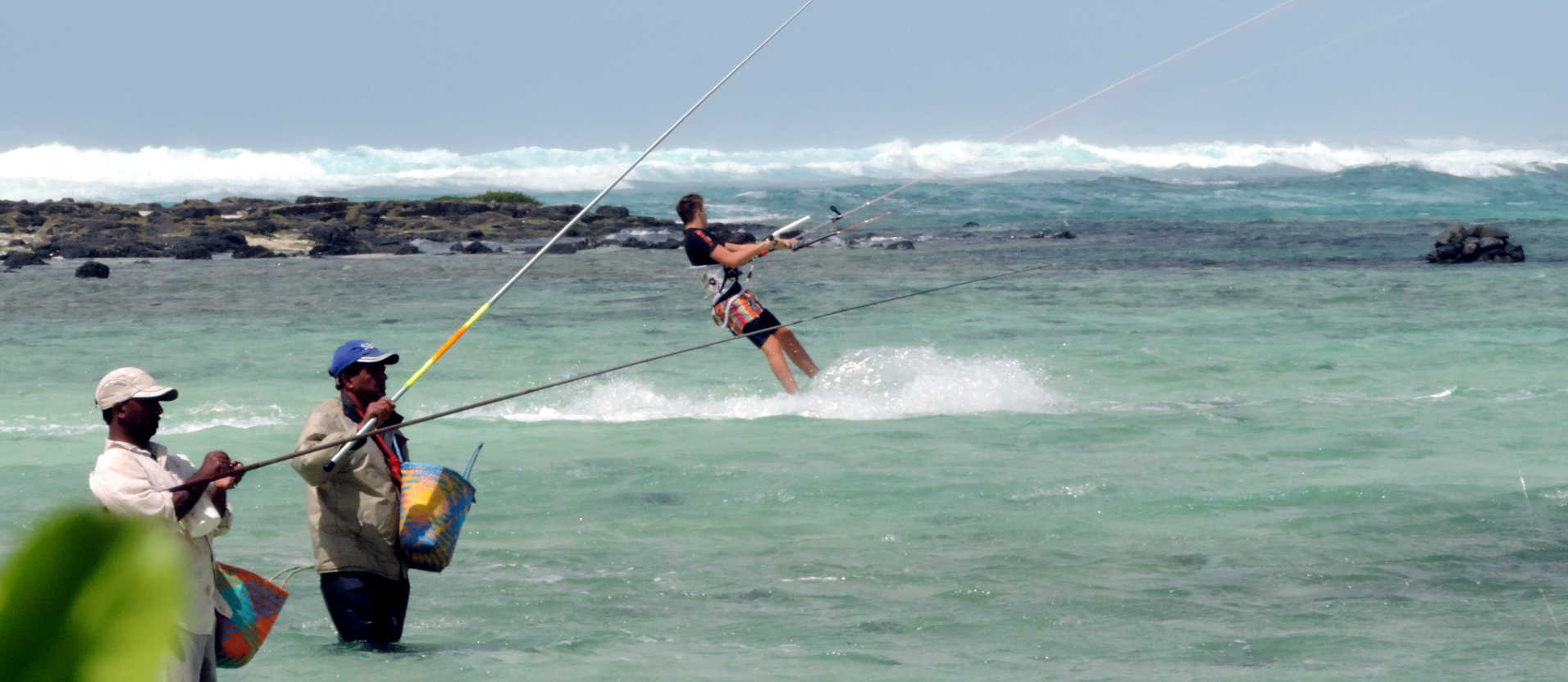Many confirmed and semi-professional kitesurfers now come to Mauritius regularly; mainly to ride the now famous waves of “One Eye” Le Morne but also to enjoy the lagoon-riding and crossing possibilities around Mauritius.
Confirmed riders can ride in Mauritius pretty easily but we strongly recommend taking advice with as many local riders as possible before choosing your launching spots as many places have their peculiarities that can become hazards to the uninformed riders.

Kitesurfing in Mauritius is possible almost all year round but chances of enjoying good kitesurfing conditions during a 10-day stay are greatly increased during the austral winter months of June to November where the cycle is generally 4 days of good wind, 2 days average and 1 day without.
The North (North-East) is “rideable” almost all year round. Although a bit gusty and too “off shore” in winter, the lagoon of Anse La Raie / Calodyne offers wonderful conditions between November and January and in April / May, several days a week.
The East & South-East coasts count some excellent spots mainly during winter; the wind being “side / on shore” it is far less gusty along the East coast than elsewhere and will suit riders of all levels.
Based on the all-rounder Kites, we would say that the average 80 Kg lagoon rider would need:
From June to October: 7 to 9 metres at Le Morne, 10 to 12 mètres on the East coast and 9 to 12 metres in the North.
November / Beginning December: 7 to 9 metres at Le Morne, 12 mètres on the East coast and 9 to 12 metres in the North.
January, April, May: 7 to 10 metres at Le Morne, 12 mètres on the East coast and 12 metres in the North.
The pure wave riders will stick to Le Morne… Of Course! For free riders, Le Morne remains a sure bet between June and November as the acceleration from the landscape gives almost a guarantee of wind, at least as from 11.00 am. Le Morne is also a wide lagoon to enjoy but is a fairly busy place to launch and drop or to ride where everyone else is. Le Morne is windless between February and May.
THE NORTH
ANSE LA RAIE
Level: For beginners to Expert Riders.
Suitable Wind Directions: North to East.
The Pros: “Works” almost all year round, as from 12 knots announced. The flat shallow surface suits those learning tricks and even beginners as long as they are assisted.
The Cons: The rocks and trees are constant hazards. One must keep awareness alive and remain far off the shore after a quick launch.
THE EAST COAST
POSTE LAFAYETTE
The better spot is Poste Lafayette’s public beach; the one that faces the South-East.
Level: For beginners to Expert Riders.
Suitable Wind Directions: East to South.
The Pros: Plenty of space on the beach and in the lagoon.
The Cons: To be avoided on Sundays.
BELLE MARE
Level: For Beginners to Expert Riders.
Suitable Wind Directions: East to South, South-East.
The Pros: Beautiful lagoon, Plenty of Space.
The Cons: To be avoided during weekends.
PALMAR
Level: For Beginners to Expert Riders.
Suitable Wind Directions: East to South.
The Pros: Very Flat surface and no boat traffic as the lagoon “closes” upwind.
The Cons: To be avoided during weekends.
TROU D’EAU DOUCE
Level: For Beginners to Expert Riders.
Suitable Wind Directions: East to South.
The Pros: Large very flat surface windward of the islets; the spot’s name is “Joyride.”
The Cons: Lagoon of highly variable depth and wind conditions, especially near the islets. It is advisable to carefully explore the lagoon before riding afar. The “Joyride” spot is reachable only from “Ilot Mangenie” islet.
POINTE D’ESNY
The foilers’ paradise
Level: For Beginners to Expert Riders.
Suitable Wind Directions: North-east to South.
The Pros: Excellent and beautiful lagoon to ride. Several downwind destinations such as Ilot Flamand and Ile aux Cerfs several kilometres downwind… Foilers’ have a great time.
The Cons: With the increasing amount of riders, and the potential danger they represent, some property owners are getting somehow unfriendly to kitesurfers.
THE SOUTH COAST
BEL OMBRE
Level: For beginners to Expert Riders.
Suitable Wind Directions: South-east to South.
The Pros: A mixed spot suitable for beginners to confirmed flat-water riders, as well as confirmed wave riders.
The Cons: Watch-out for low tides. Launching can be tricky when the wind is too easterly.
LE MORNE
The Pros: Amazing spot for all types and levels of riders; especially for serious wave-riding.
The Cons: Just far too crowded.


